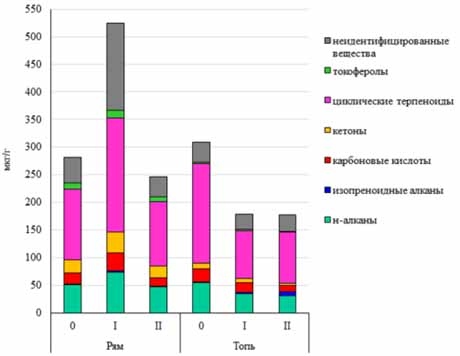Changes in the elemental composition and content of low molecular organic compounds during experimental peat destruction in the southern taiga bogs (West Siberia)
DOI:
https://doi.org/10.31251/pos.v8i1.308Keywords:
peat soils; carbon; hydrogen; nitrogen; ash elements; extractable organic compounds.Abstract
The aim of the study was to investigate the dynamics of elemental composition and the content of low-molecular organic compounds during experimental destruction of different peat types in three communities of the Bakchar Bog (West Siberia, Russia).
Location and time of the study. The field experiment was carried out in three communities of the Bakchar Bog (56°51” N, 82°50” E): the pine-dwarf shrub-Sphagnum community (ryam), dwarf shrub-cotton grass-Sphagnum community at the edge of a poor fen and the sedge-Sphagnum community in the center of the poor fen. After preparation peat samples were placed at the depths of 5-10 and 25-30 cm, and after 4 and 16 months the samples were collected for analyses.
Methods. Total soil carbon, hydrogen and nitrogen content was determined on a Perkin Elmer 2400 Series II CNHS/O analyzer (USA). Phosphorus was determined colourimetrically, whereas soil exchangeable potassium, sodium, calcium, magnesium and iron were determined by atomic absorption. Extractive low-molecular organic compounds were analyzed by gas chromatography-mass spectrometry (Clarus 500 MS gas chromatograph, Perkin Elmer, USA) with a quadrupole detector.
Results. During the experiment, the carbon content decreased in all samples, while the nitrogen content and the H/C and C/N ratios changed differently among communities and depths. The C/N ratio was not the important driver of the peat decomposition intensity at the studied sites. The phosphorus, potassium and sodium content decreased in most cases. The concentration of magnesium and iron increased in the fen communities, whereas calcium decreased in the dwarf shrub-cotton grass-Sphagnum community of the fen edge. The aerobic layer of the ryam differed from other locations by the increased concentration of all the elements. After destruction the content of low-molecular organic compounds increased in the aerobic zone of the ryam and decreased in the fen. The content of individual groups of organic compounds changed differently, i.e. from a small change to a fourfold one.
Conclusions. Specific patterns of peat decomposition in the Bakchar Bog were found for each of the studied communities, based on the dynamics of the elemental composition and low-molecular organic compounds. In the aerobic zone of the ryam, the concentration of all elements and organic compounds increased, accompanied by the greatest mass loss. In the dwarf shrub-cotton grass-Sphagnum community, the concentration of elements both decreased and increased, and the content of organic compounds decreased. In the sedge-Sphagnum community, the leaching of the elements occurred. Most likely, such dynamics was due to the development of different communities of destructors: micromycetes in the aerobic zone of the ryam soils and bacteria at the edge of the poor fen. In the deep peat layer of the ryams and in the center of the poor fen, decomposition was negligible due to anaerobic conditions.
Downloads

Downloads
Published
How to Cite
Issue
Section
License
Copyright (c) 2025 The Journal of Soils and Environment

This work is licensed under a Creative Commons Attribution 4.0 International License.






